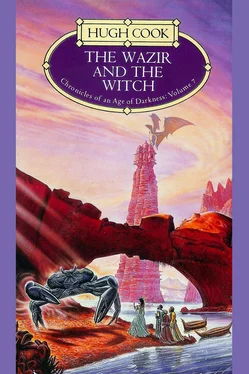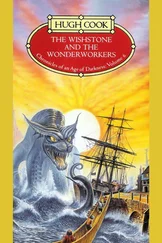Hugh Cook - The Wazir and the Witch
Здесь есть возможность читать онлайн «Hugh Cook - The Wazir and the Witch» весь текст электронной книги совершенно бесплатно (целиком полную версию без сокращений). В некоторых случаях можно слушать аудио, скачать через торрент в формате fb2 и присутствует краткое содержание. Жанр: Фэнтези, на английском языке. Описание произведения, (предисловие) а так же отзывы посетителей доступны на портале библиотеки ЛибКат.
- Название:The Wazir and the Witch
- Автор:
- Жанр:
- Год:неизвестен
- ISBN:нет данных
- Рейтинг книги:5 / 5. Голосов: 1
-
Избранное:Добавить в избранное
- Отзывы:
-
Ваша оценка:
- 100
- 1
- 2
- 3
- 4
- 5
The Wazir and the Witch: краткое содержание, описание и аннотация
Предлагаем к чтению аннотацию, описание, краткое содержание или предисловие (зависит от того, что написал сам автор книги «The Wazir and the Witch»). Если вы не нашли необходимую информацию о книге — напишите в комментариях, мы постараемся отыскать её.
The Wazir and the Witch — читать онлайн бесплатно полную книгу (весь текст) целиком
Ниже представлен текст книги, разбитый по страницам. Система сохранения места последней прочитанной страницы, позволяет с удобством читать онлайн бесплатно книгу «The Wazir and the Witch», без необходимости каждый раз заново искать на чём Вы остановились. Поставьте закладку, и сможете в любой момент перейти на страницу, на которой закончили чтение.
Интервал:
Закладка:
Then Vorn the Gladiator acts. He has noticed an orifice at the rear end of the malatothapus. Keeping hold of the brute’s tail with his left hand, he plunges the right into this orifice, driving his right arm into the hot and humid flesh until it is buried to the shoulder. Vorn claws at the monster’s innards with his fingernails, which are specially sharpened so he can gouge out eyes in close quarters combat.
The malatothapus bellows with agony, then faints from a surfeit of pain. As the monster swoons, Vorn pulls his arm free. He recovers the great sword Zaftig and hacks off the head of the brute.
‘My hero!’ says the Princess Nuboltipon, running to him with open arms.
Von embraces her, though one arm is smeared with hot brown dung from fingertips to shoulder, and the other is much besplattered with the blood of the malatothapus. He crushes her to his breast. And, that night, duly reprieved and happily married, he crushes her to the bed, her perfume swooning around her as he thrusts an unmentionable part of his anatomy into a princessly orifice of hers which is equally unmentionable.
If you have an appetite for tales of such things, then by all means turn to the indulgent pages of the books of the above-mentioned Chalman Puro. But do not expect to find any such frivolous amusement here! The historian is happy to say that no such lurid incidents will be recorded in this tome. Instead, here we have a sober book of history, complete with statistical analysis where appropriate. Here is one such analysis:
It has been reliably computed that if the eyeballs of all the inhabitants of Untunchilamon were pulped together in a barrel, this would yield enough fluid to provide three baths for Aldarch the Third, Mutilator of Yestron. With equal reliability, it has been computed that the same amount of eyeball juice could provide the formidable Al’three with an infinite number of baths were he prepared to reuse the substance indefinitely.
This statistic has been derived from firm experimental evidence obtained by torturers working in the employ of the Mutilator of Yestron, and is mentioned here in order to indicate something of the character of Aldarch the Third to anyone who may by chance be unfamiliar with his history.
That character is part of the necessary background to this history, for virtually everything that was done in, on, around and underneath the city of Injiltaprajura in the final days of the reign of the Empress Justina was done with reference to the tastes, manners and mores of Al’three.
Even people’s dreams were conditioned by the activities of the Mutilator. Though that tyrant was many leagues from Untunchilamon, it was customary for the blood spilt by his armies to pour in smoking rivers through the dreams of the people of Untunchilamon. Blood smoking, stinking, drenching, drowning — of such things is nightmare made.
Of such we will not speak again, trusting that the reader will hold it in mind throughout the rest of this history, and will not need to be reminded from paragraph to paragraph that ‘when x did y he had the rightful expectations of Aldarch the Third very much in mind’.
However, while we trust the intelligence and intellectual powers of our readership, repetition of some thematic motifs will be necessary if only because pattern (and, hence, repetition) is an unavoidable part of life. Therefore it will (for example) be recorded (more than once) that the sun rose; and, again, that it set. From this, only the rash will presume that the historian presumes his readers to be so imbecilic that they need to be regularly reminded of the behaviour of the sky’s major luminary. Likewise, only a harebrained speculator would presume that the succession of night by day and day by night speaks of some hidden symbolic scheme.
The historian makes mention of this because the world is not free from either the rash or the harebrained.
With particular regard to the harebrained, it needs to be stressed that this is a history written with painstaking regard to fact, and the historian has nowhere indulged in any poetic flights of fancy or invention. Thus, while blood is necessarily one of the dominant thematic elements of this text, no ‘symbolic scheme’ is intended or implied, for such nonsense belongs to the province of the poets. Rather, it happens that the ruling colour of Untunchilamon is lifeblood red, and this is a fact of geography which the historian did not invent and cannot alter.
The island of Untunchilamon has red rock known as bloodstone, reefs of red coral, seas of red seaweed, intermittent plagues of red plankton, beaches of red sand (ground coral and bloodstone mixed), and tropical sunsets which tend to be of a singularly sanguinary nature. The historian might therefore in fairness say:
Untunchilamon: island of blood!
But to say this is not to imply (after the style of Greven Jing, whom we have neatly disembowelled above) an atmosphere of horror. True, what one remembers most after a prolonged incarceration upon the island is the oppressive bloodstone, the sweltering heat, and the edible fires of the heavily spiced food in which the local inhabitants tend to indulge themselves.
But the fact is that, overall, Untunchilamon is a tolerably pleasant place. One can escape the heat by retreating to the labyrinthine underground mazes Downstairs. Or, if you do not care to venture Downstairs yourself, you can ameliorate the effects of heat by indulging in ice which others have rescued from those ancient machineries which fabricate that useful substance in the depths. Apart from ice, hidden machines also make (or so we presume, for it is the simplest of available explanations) the potable water which feeds Injiltaprajura’s eversprings.
Injiltaprajura is, of course, the capital city (the only city) of Untunchilamon, and is sited where it is (on the shores of the Laitemata Harbour) expressly because of the water, ice, dikle and shlug manufactured by the machines of Downstairs.
On the Laitemata one might find (at night) Shabble admiring Shabbleself in the nightwater lightmirror. One would also find (at any time of day or night) the island of Jod. This was (and, doubtless, is still) a small island notable chiefly for one building in spectacular white marble, that building being the Analytical Institute which housed Jod’s Analytical Engine.
On a hot day on the island of Jod, we find the master chef Pelagius Zozimus preparing a platter of tolfrigdala-kaptiko, that dish which consists of fried seagull livers plus a dash of basilisk gall, the said dish being served with side helpings of baked yams and lozenges of dried jelly fish.
The perceptive reader will recall that the very same dish was mentioned in the first chapter of this history, and may suspect the existence of an unpardonable coincidence.
The true explanation is that the historian is working with a complete set of Pelagius Zozimus’s favourite recipes on his desk, and is interleaving the labour of composing this history with the pleasures of trying out those recipes (to the extent to which the ingredients are obtainable in this region of the island of Quilth).
Thus, when the historian came to record the departure of Jean Froissart from the city of Bolfrigalaskaptiko on the River Ka (just upstream from the great lagoon of Manamalargo on the western shores of the continent of Yestron) it happened that tolfrigdalaptiko infiltrated the text because the recipe for the dish was on his desk; the very taste of the stuff was on his tongue; the pan in which he had cooked it was sitting in a washing barrel together with all those pans, pots and casserole dishes used by the historian over the last ten days; and the historian’s favourite cockroach was feeding on one stray seagull liver which, having fallen to the floorboards, had failed to slip between the cracks between those boards.
Читать дальшеИнтервал:
Закладка:
Похожие книги на «The Wazir and the Witch»
Представляем Вашему вниманию похожие книги на «The Wazir and the Witch» списком для выбора. Мы отобрали схожую по названию и смыслу литературу в надежде предоставить читателям больше вариантов отыскать новые, интересные, ещё непрочитанные произведения.
Обсуждение, отзывы о книге «The Wazir and the Witch» и просто собственные мнения читателей. Оставьте ваши комментарии, напишите, что Вы думаете о произведении, его смысле или главных героях. Укажите что конкретно понравилось, а что нет, и почему Вы так считаете.












